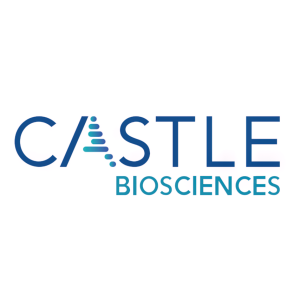Castle Biosciences Presents New Data from Collaboration with the National Cancer Institute’s (NCI) Surveillance, Epidemiology and End Results (SEER) Program
Linked data from Castle’s ongoing collaboration with the NCI to link testing data with data from the SEER Program’s registries showed that DecisionDx®-Melanoma can provide significant risk stratification and identify patients with a low risk of death who may potentially forego unnecessary adjuvant therapies
Analysis of the first set of NCI/SEER-linked uveal melanoma patient data showed that DecisionDx-UM accurately stratified UM patients’ risk of death, which is important for guiding management decisions
“Castle is committed to providing innovative and clinically actionable tests that can guide more informed and more personalized treatment decisions,” said
DecisionDx®-Melanoma | Poster #: P- 036
Improving patient selection for adjuvant therapy: Considerations for the role of the 31-gene expression profile test
Pembrolizumab (KEYTRUDA®) received expanded FDA approval as an adjuvant therapy for patients with stage IIB-IIC melanoma in late
In the study, DecisionDx-Melanoma was a statistically significant and independent predictor of melanoma-specific survival (MSS), consistent with previously published retrospective and prospective studies. Patients with stage IIB or IIC melanoma and a low-risk (Class 1A) DecisionDx-Melanoma test result had higher three-year MSS than patients with a high-risk (Class 2B) result (Class 1A:
The poster may be viewed here.
DecisionDx®-UM | Poster #: P- 035
A collaborative outcome study in uveal melanoma with the National Cancer Institute’s Surveillance, Epidemiology, and End Results Program Registries (NCI SEER): Performance of the 15-gene expression profile test in clinically tested uveal melanoma patients
The study evaluated the risk-stratification performance of DecisionDx-UM in a real-world, unselected, clinically tested cohort of patients with UM (n=615). On behalf of the SEER registries, a third-party honest broker conducted a linkage of all patients with UM from 16 NCI SEER registries to those clinically tested with DecisionDx-UM. The study included all linked cases diagnosed in 2018 with survival outcome information and a DecisionDx-UM test result. Patients with stage IV disease (evidence of distant metastasis) at initial presentation were excluded from the analysis.
In the study, DecisionDx-UM accurately stratified patient risk of death from UM. Patients with a low-risk (Class 1A) DecisionDx-UM test result had higher 18-month overall survival (OS) and 18-month MSS than patients with a high-risk (Class 2) test result (OS=
The poster may be viewed here.
About DecisionDx®-Melanoma
DecisionDx-Melanoma is a gene expression profile risk stratification test. It is designed to inform two clinical questions in the management of cutaneous melanoma: a patient’s individual risk of sentinel lymph node (SLN) positivity and a patient's personal risk of melanoma recurrence and/or metastasis. By integrating tumor biology with clinical and pathologic factors using a validated proprietary algorithm, DecisionDx-Melanoma is designed to provide a comprehensive and clinically actionable result to guide risk-aligned patient care. DecisionDx-Melanoma has been shown to be associated with improved patient survival and has been studied in more than 9,000 patient samples. DecisionDx-Melanoma’s clinical value is supported by more than 35 peer-reviewed and published studies, providing confidence in disease management plans that incorporate the test’s results. Through
About DecisionDx®-UM
DecisionDx-UM is Castle Biosciences’ 15-gene expression profile (GEP) test that uses an individual patient’s tumor biology to predict individual risk of metastasis in patients with uveal melanoma. DecisionDx-UM is the standard of care in the management of newly diagnosed uveal melanoma in the majority of ocular oncology practices in
About
Castle’s current portfolio consists of tests for skin cancers, uveal melanoma, Barrett’s esophagus and mental health conditions. Additionally, the Company has active research and development programs for tests in other diseases with high clinical need, including its test in development to predict systemic therapy response in patients with moderate-to-severe psoriasis, atopic dermatitis and related conditions. To learn more, please visit www.CastleBiosciences.com and connect with us on LinkedIn, Facebook, Twitter and Instagram.
DecisionDx-Melanoma, DecisionDx-CMSeq, DecisionDx-SCC, MyPath Melanoma, DiffDx-Melanoma, DecisionDx-UM, DecisionDx-PRAME, DecisionDx-UMSeq, TissueCypher and IDgenetix are trademarks of
Forward-Looking Statements
This press release contains forward-looking statements within the meaning of Section 27A of the Securities Act of 1933, as amended, and Section 21E of the Securities Exchange Act of 1934, as amended, which are subject to the “safe harbor” created by those sections. These forward-looking statements include, but are not limited to, statements concerning: the potential of DecisionDx-Melanoma and DecisionDx-UM to accurately stratify risk of death from melanoma and guide more informed and more personalized treatment decisions; and the potential of DecisionDx-Melanoma to provide significant risk stratification that can identify patients with a low risk of death who may potentially forego unnecessary adjuvant therapies, thereby reducing healthcare costs and adjuvant therapy-related adverse events; and the potential of DecisionDx-Melanoma to identify patients who are at a much higher likelihood of progressing, potentially enabling more aggressive decisions regarding the use of adjuvant therapy. The words “can,” “could,” “may,” “potential” and similar expressions are intended to identify forward-looking statements, although not all forward-looking statements contain these identifying words. We may not actually achieve the plans, intentions or expectations disclosed in our forward-looking statements, and you should not place undue reliance on our forward-looking statements. Actual results or events could differ materially from the plans, intentions and expectations disclosed in the forward-looking statements that we make. These forward-looking statements involve risks and uncertainties that could cause our actual results to differ materially from those in the forward-looking statements, including, without limitation: subsequent study or trial results and findings may contradict earlier study or trial results and findings or may not support the results obtained in these studies, including with respect to the discussion of DecisionDx-Melanoma and DecisionDx-UM in this press release; actual application of our tests may not provide the aforementioned benefits to patients; and the risks set forth under the heading “Risk Factors” in our Quarterly Report on Form 10-Q for the three months ended
View source version on businesswire.com: https://www.businesswire.com/news/home/20221027005110/en/
Investor Contact:
czuckero@castlebiosciences.com
Media Contact:
amarshall@castlebiosciences.com
Source:







